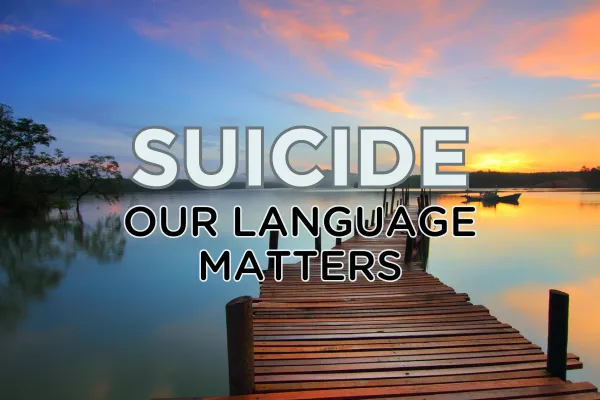General Inquiries: (587) 333-6349 - info@sanostate.com



Suicide: Our Language Matters
Our language matters. Most of the time, we’re aware when we say something hurtful, but what about the times when we say things that unknowingly sting because we just don’t know?
When talking about suicide, it’s easy to feel uncomfortable and inadvertently use words that instill judgment and/or contribute to unnecessary stigma. Using neutral, empathetic, and non-judgemental language is crucial in these conversations.
Why Is Informed Language Important When It Comes To Suicide?
It Reduces Stigma
Language plays a pivotal role in reducing the stigma around self-harm and suicide. When we use non-judgmental, objective, and safe language, we help dismantle the negative connotations associated with suicide.
It Dispels Myths
Informed language helps challenge and correct common myths around suicide. Using precise and thoughtful language promotes a more accurate understanding of suicide. This approach encourages an open conversation and can lead to better support for people affected by suicide.
It Encourages Those Affected To Seek Help
When we use empathetic, open, and non-judgemental language, those who are affected by suicide are more likely to seek the support they need. By fostering an objective and compassionate approach to suicide, we create an environment where individuals feel comfortable talking about their experiences and are more inclined to reach out for professional help.
What Guidelines Should Be Followed When We Talk About Suicide?
Use Person-First Language
A person-first language focuses on the individual rather than their struggles, which fosters respect for them and their experiences. Person first language is also valuable in other contexts, such as when discussing physical or mental health ailments.

Use Safe Language Around Suicide Attempts
When discussing suicide attempts, approach the topic with empathy and factuality to create a more supportive environment.

Side Note: The phrase “commit suicide” implies criminality, which contributes to the stigma around suicide. It’s important to note that suicide has been decriminalized in Canada since 1972.
Use Safe Language About Suicide at a Systemic Level
Certain demographics experience higher suicide rates than others. While identifying these populations is important for suicide prevention, we MUST use terminology that reduces stigma and avoids the perpetuation of stereotypes.

Conclusion
The language we use when discussing suicide is more than a choice of words; it’s a reflection of our understanding and compassion. By adopting informed, empathetic, and non-judgemental language, we help reduce stigma, dispel harmful myths, and create a supportive environment that encourages those affected by suicide to seek help. Choosing to be mindful of our words can make a significant impact on the lives of those around us.
If this is an area where you could use support, connect with us HERE or by calling
587-333-6349. 💙
If you or someone you love is in imminent threat of harm to self please call 911 or The Distress Centre - 403-266-4357 or the National Suicide Hotline at 988.
References
Her Majesty the Queen, Minister of Health, & Agency of Canada. (2018). LANGUAGE MATTERS: SAFE LANGUAGE AND MESSAGES FOR SUICIDE PREVENTION [Book]. Public Health Agency of Canada. https://www.canada.ca/content/dam/phac-aspc/documents/services/publications/healthy-living/language-matters-safe-communication-suicide-prevention/pub-eng.pdf
Disclaimer
Our content is for informational and educational purposes and is not a replacement for professional advice, diagnosis, or treatment. If you're facing mental health concerns, please seek help from a qualified professional for personalized guidance. Every individual's situation is unique, so use the information here at your discretion. While we strive for accuracy, the field of psychology is ever-evolving, and our content may not always reflect the latest research. Please prioritize your privacy by avoiding sharing personal information in comments or interactions. Your well-being is our top concern, so use our content for educational purposes, but remember to rely on professionals for your specific needs.
General Inquiries:
Our Locations:
Additional Resources:
About Us:
We strive for excellence in psychological treatment. We are committed to providing professional, caring, innovative, and research-based services.
© 2024 Sano State Taylored Psychology. All Rights Reserved.

